Pennsylvania State Police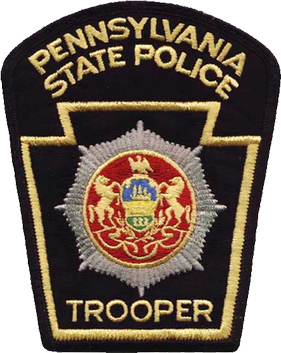
Pennsylvania State Police
The Pennsylvania State Police was created and signed into law by Governor Samuel W. Pennypacker on May 2, 1905. The department became the first uniformed police organization of its kind in the United States and a model for other state police agencies throughout the nation.
Opposition to the department's creation was strong and persistent. Because of the fear, mostly by organized labor, that the State Police would be used as a private army, the original complement was limited by law to only 228 men. They were to patrol Pennsylvania's entire 45,000 square miles.
The force was divided into four Troops across the state.
By 1919, the demand for additional State Police units brought about the first increase in complement, authorizing a maximum force of 415 men. That same year saw the transfer of State Fire Marshal duties to the State Police. Also in 1919, the State Police established motorcycle patrols to deal with the growing number of motorists.
The State Highway Patrol was created in 1923 within the Department of Highways to enforce the vehicle laws of Pennsylvania's burgeoning highway system.
In 1927, the Superintendent established the first two State Highway Patrol Troops. They were Troop A, Harrisburg, and Troop B, Greensburg. that year also saw the First State Highway Patrolman killed in the line of duty.
In 1935, Troop F, Franklin, became the sixth and last Troop to be established by the Highway Patrol before the merger with the State Police on June 29, 1937. The new department was called the Pennsylvania Motor Police.
In February 1938, the Commissioner ordered 267 passenger cars painted white with black hoods and Pennsylvania Motor Police lettering on the door. These cars became known as Ghost Cars.
On April 28, 1943, the Pennsylvania Motor Police became the Pennsylvania State Police. In 1956, the title "Trooper" commenced.
On September 1, 1961, the State Police officially began radar speed checks. In 1963, the PSP permitted married men to apply to the Force for the first time. In August of 1989, after a 50-year hiatus, the Department returned to patrolling the state's highways on motorcycles.
Twelve Harley Davidson motorcycles were assigned to Bethlehem, Harrisburg, Philadelphia and Pittsburgh to respond to accidents along heavily traveled highways. The program was designed to help restore traffic on major, densely traveled highways, where conventional vehicles could not respond quickly.
On July 31, 1993, The Pennsylvania State Police became the largest accredited police agency in the world. In order to gain accredited status from the Commission on Accreditation for Law Enforcement Agencies, the department had to comply with 733 professional police standards.
The earliest days of the Pennsylvania State Police/State Highway Patrol/Motor Police have no real confirmed license plate usage until the late 1930's. A photo from 1938 shows a Pennsylvania Motor Police "ghost car" bearing a 1938 "OFFICIAL" issue license plate number 31880, so it can be surmised that previous "OFFICIAL" base plates may have been used prior, however this is not yet confirmed by photographic or written record. It is also entirely possible that standard passenger license plates may have been used as well during these earliest years of the agency.
It was in 1939 where it appeared that marked PMP cars began running five-numbered passenger series license plates and the trend continued through at least 1957 when the agency went back to OFFICIAL USE ONLY "Commonwealth" license plates for their marked patrol vehicles.
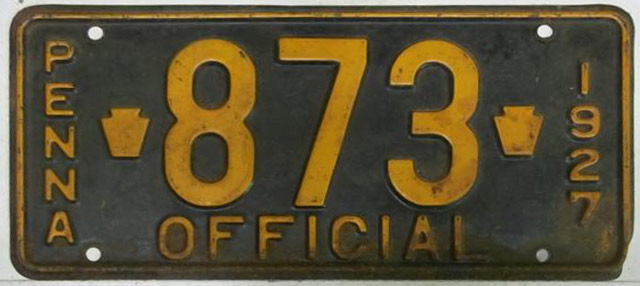 1927 State Official issue.
1927 State Official issue. 
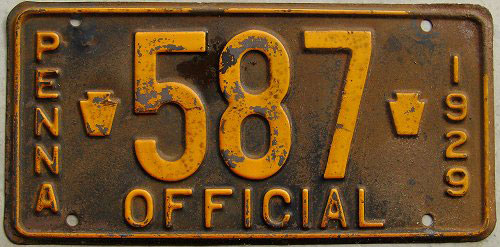 1929 State Official issue.
1929 State Official issue. 
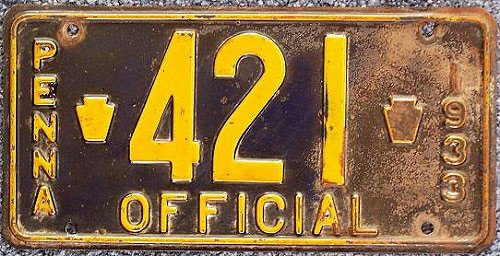 1933 State Official issue.
1933 State Official issue. 
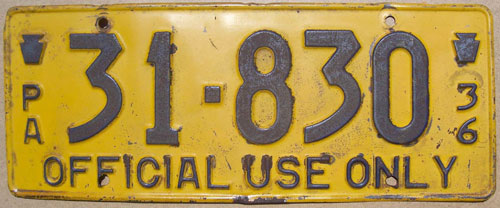 1936 Official Use issue. Embossed steel.
1936 Official Use issue. Embossed steel.
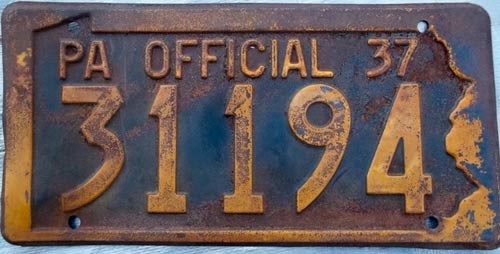 1937 Official Use issue.
1937 Official Use issue. 
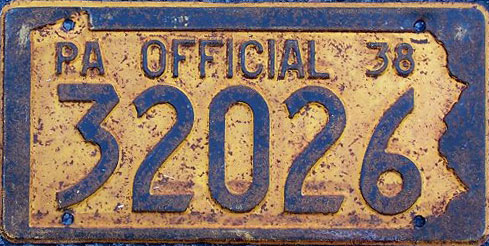 1938 State Official issue.
1938 State Official issue. 
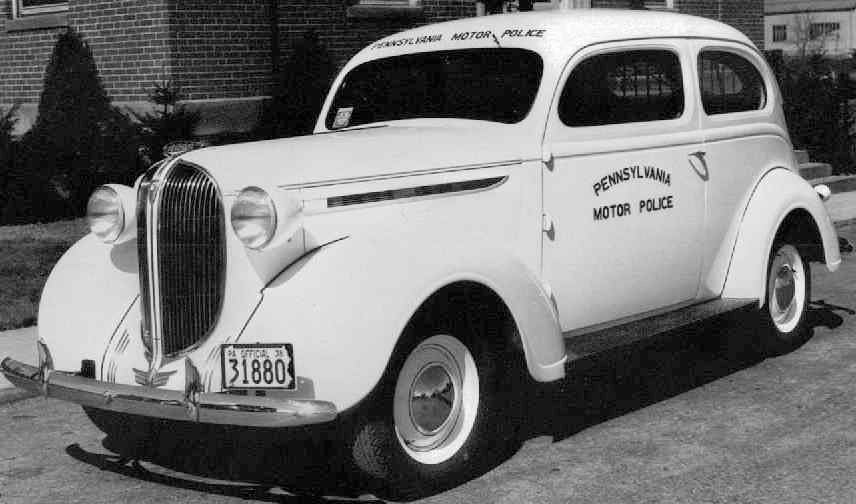
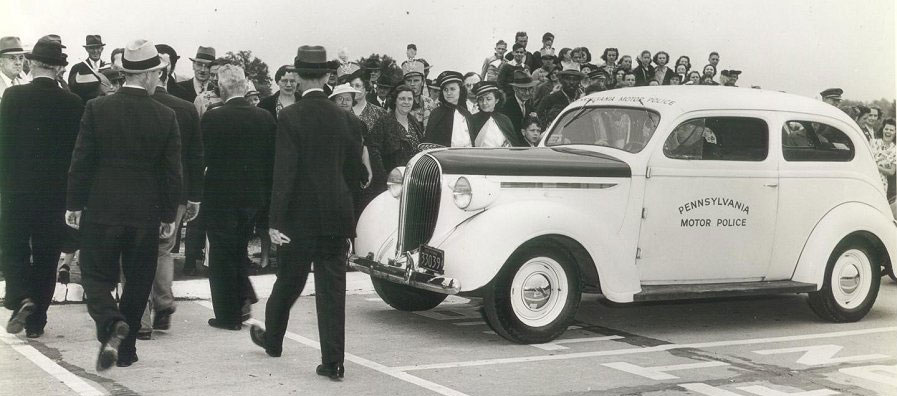
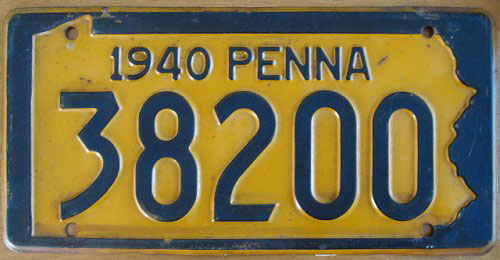 1940 five-number passenger car issue. Embossed steel.
1940 five-number passenger car issue. Embossed steel.
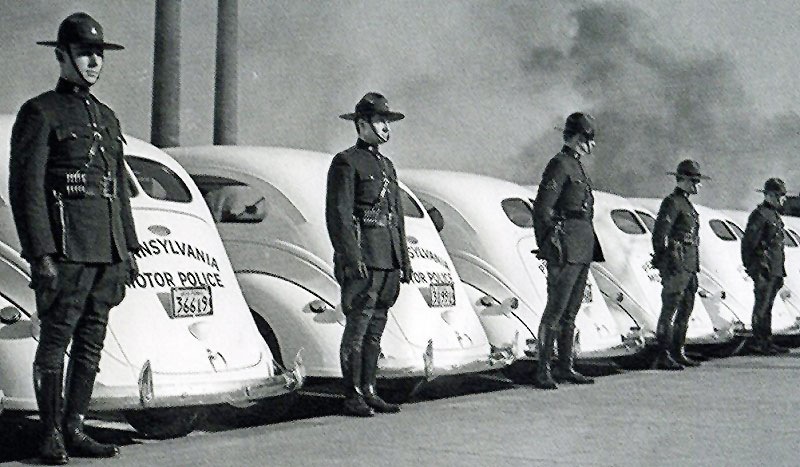
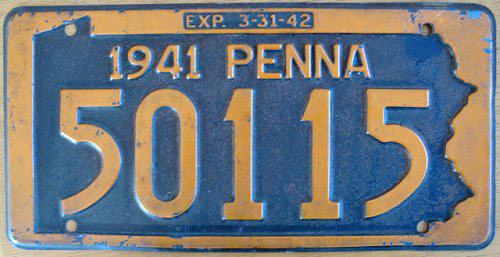 1941 five-number passenger car issue. Embossed steel.
1941 five-number passenger car issue. Embossed steel.
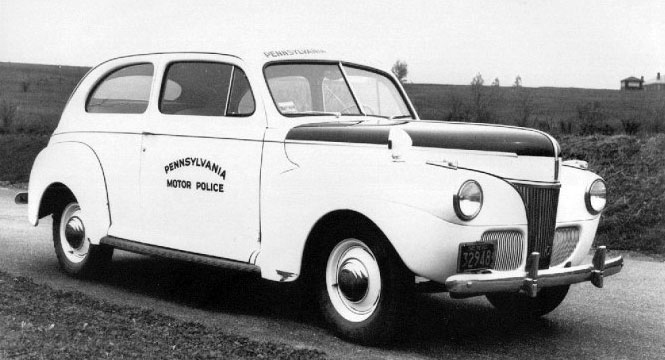
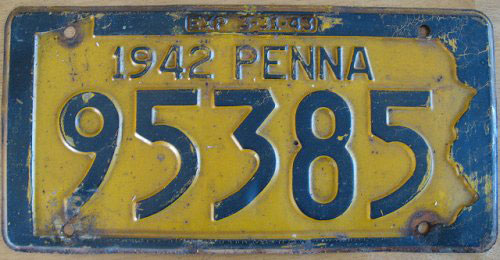 1942 five-number passenger car issue. Embossed steel.
1942 five-number passenger car issue. Embossed steel.
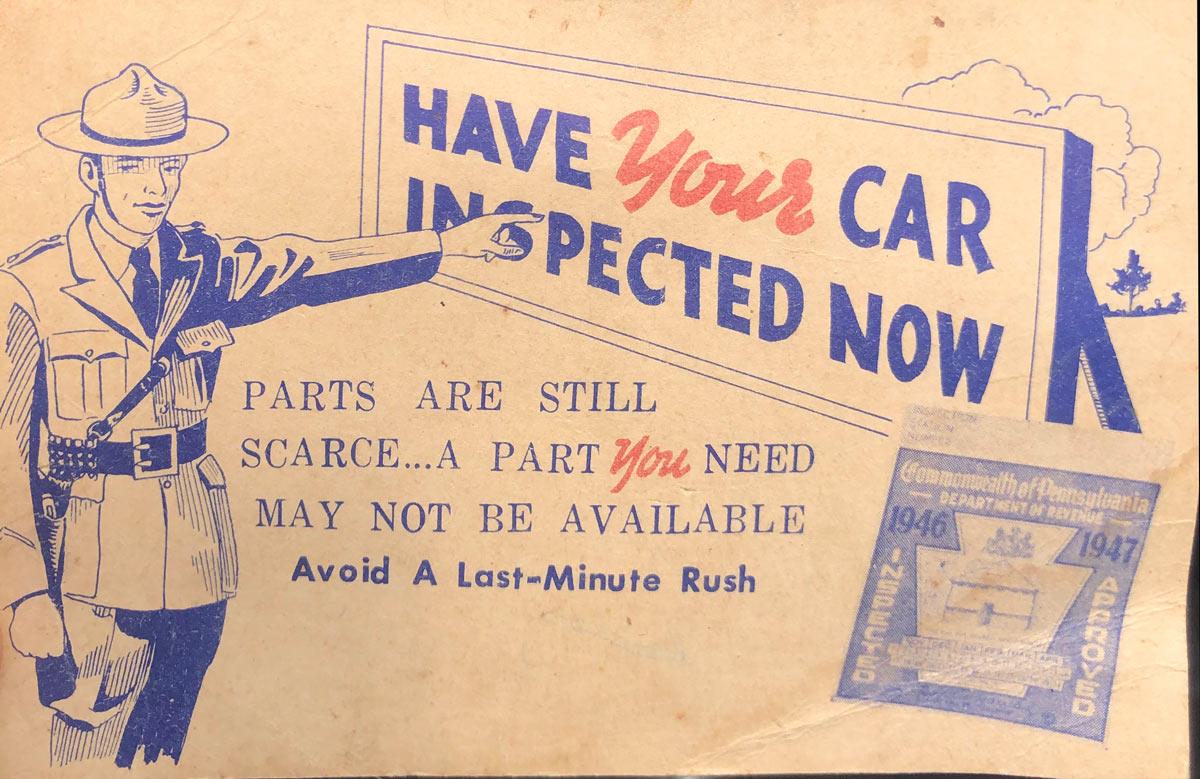 Post-World War 2 Inspection reminder during auto parts shortage.
Post-World War 2 Inspection reminder during auto parts shortage.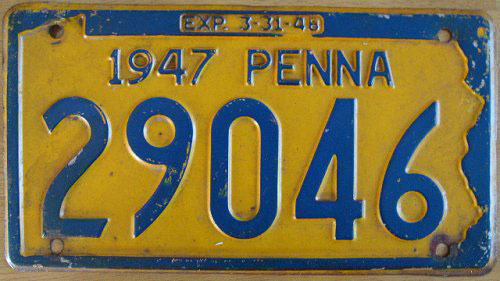 1947 five-number passenger car issue. Embossed steel.
1947 five-number passenger car issue. Embossed steel.
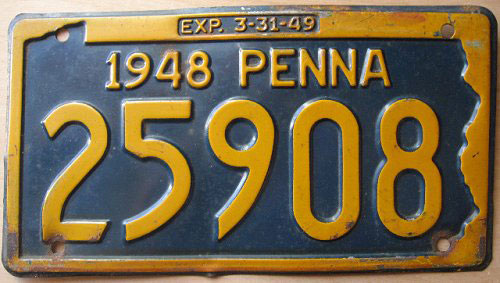 1948 five-number passenger car issue. Embossed steel.
1948 five-number passenger car issue. Embossed steel.
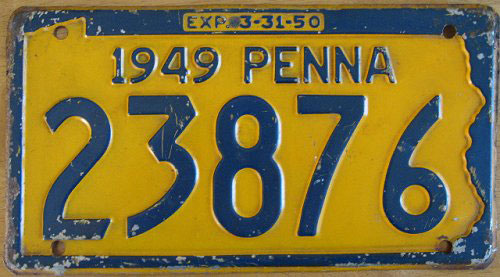 1949 five-number passenger car issue. Embossed steel.
1949 five-number passenger car issue. Embossed steel.
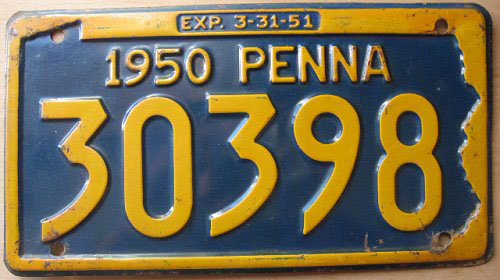 1950 five-number passenger car issue. Embossed steel.
1950 five-number passenger car issue. Embossed steel.
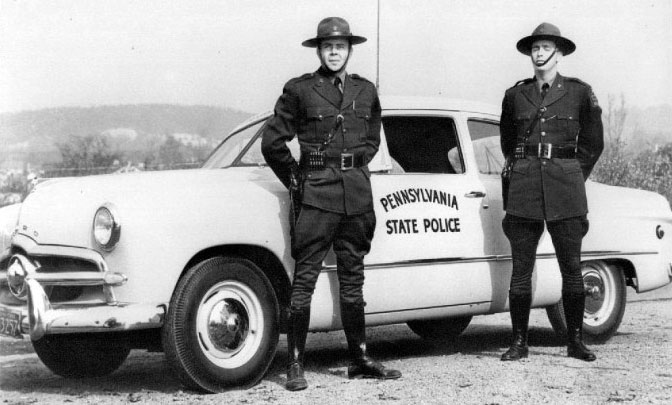
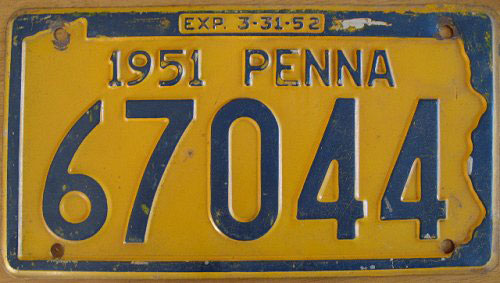 1951 five-number passenger car issue. Embossed steel.
1951 five-number passenger car issue. Embossed steel.
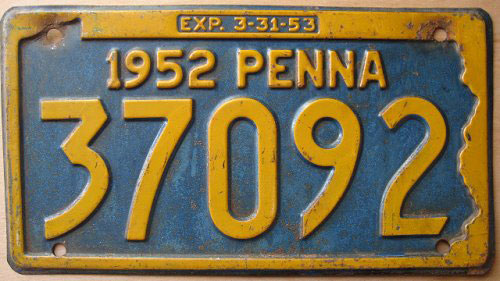 1952 five-number passenger car issue. Embossed steel.
1952 five-number passenger car issue. Embossed steel.
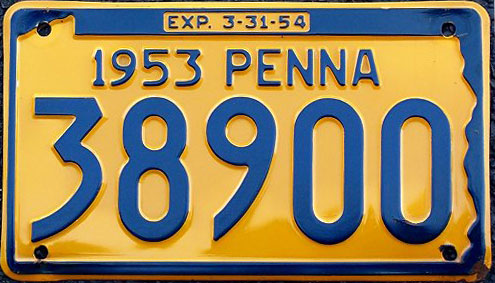 1953 five-number passenger car issue. Embossed steel.
1953 five-number passenger car issue. Embossed steel.
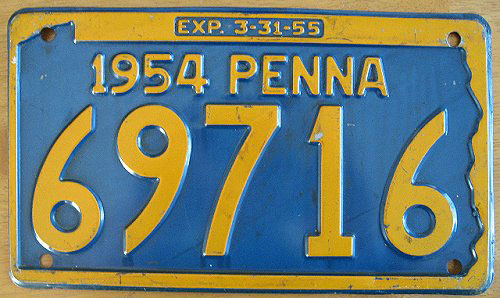 1954 five-number passenger car issue. Embossed steel.
1954 five-number passenger car issue. Embossed steel.
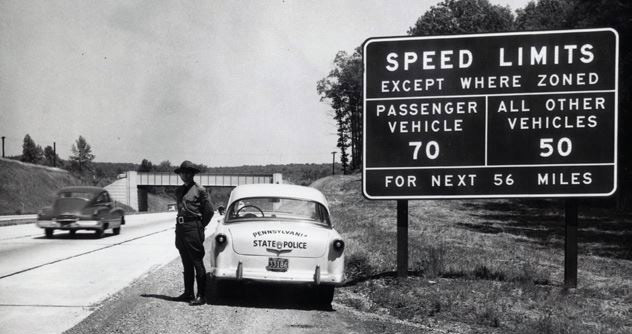 Plate # 33186.
Plate # 33186.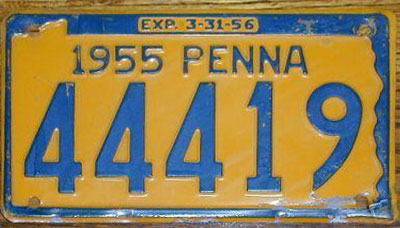 1955 five-number passenger car issue. Embossed steel.
1955 five-number passenger car issue. Embossed steel.
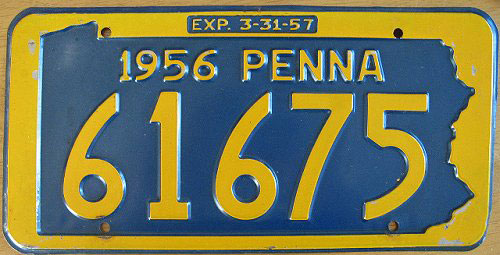 1956 five-number passenger car issue. Embossed steel.
1956 five-number passenger car issue. Embossed steel.
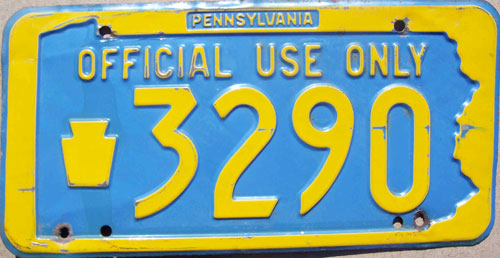 1957-1965 Official Use "Commonwealth" issue.
1957-1965 Official Use "Commonwealth" issue. 
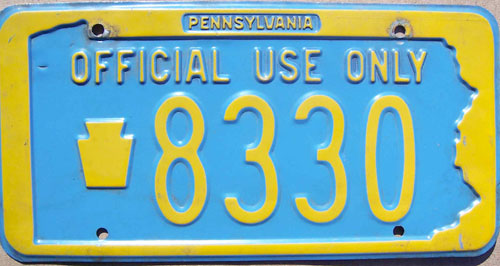 1958-1965 Official Use "Commonwealth" issue.
1958-1965 Official Use "Commonwealth" issue. 
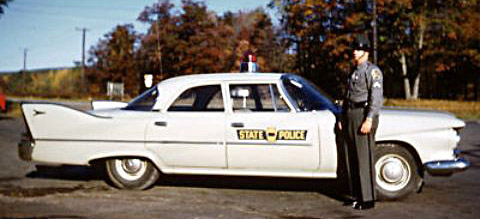
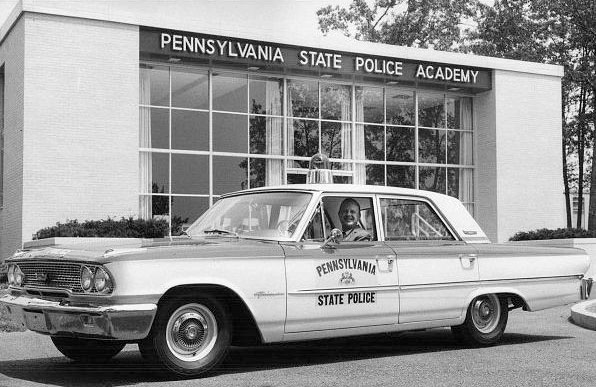
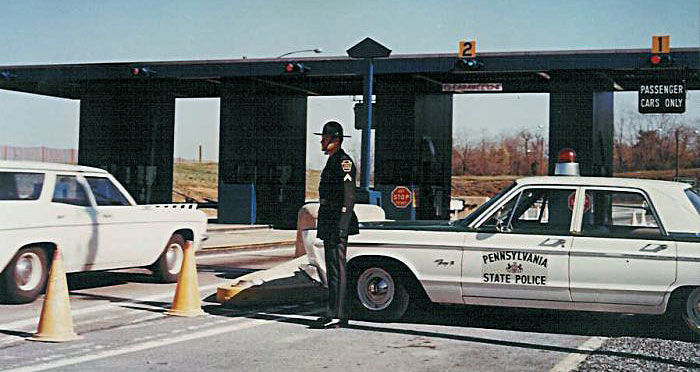
In 1965, a new Commonwealth OFFICIAL USE ONLY license plate was issued. The plate was made of embossed aluminum and had dark blue characters and embossing over a yellow-orange background. The state outline was featured once again as a perimeter of the plate and PENNSYLVANIA was embossed in small letters at the top center of the plate in a yellow-orange recess within the dark blue background. OFFICIAL USE ONLY was embossed above the registration number which consisted of the prefix PA followed by a small keystone-shaped dash and a number up to four digits.
These plates were used on new fleet vehicles as the previous Commonwealth plates were used on older vehicles until they were miled-out. This issue ceased being issued in 1968, but was still used well-into the early 1970's.
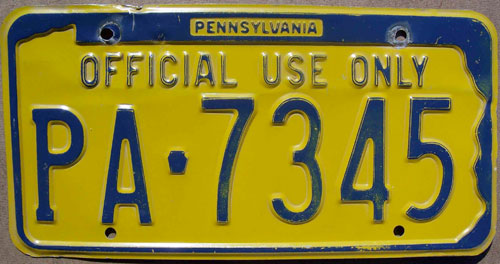 1965-1971 Official Use "Commonwealth" issue.
1965-1971 Official Use "Commonwealth" issue.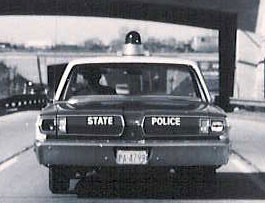
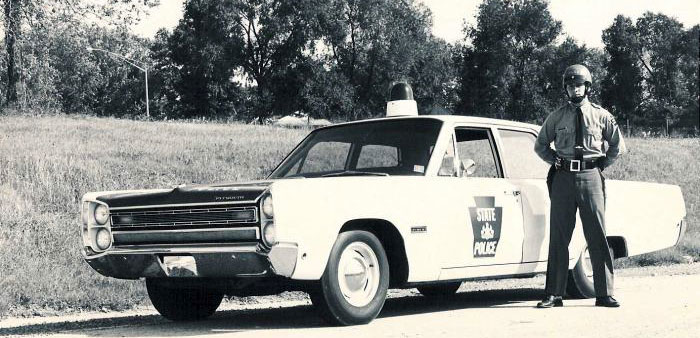
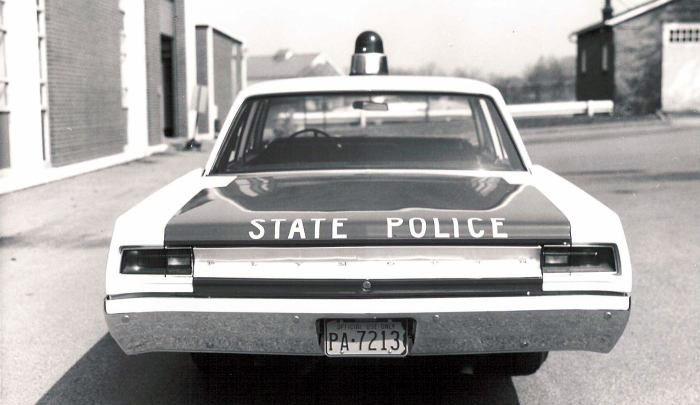
By 1968, the numbers attributed to Commonwealth vehicles were reaching the 10,000 mark, and the 1965 OFFICIAL USE ONLY license plates could only go to 9999. So it was in that year that a new Commonwealth license plate was issued to accommodate the higher registration numbers. The color scheme was the same as the 1965 issue, however the state outline was much thinner. OFFICIAL USE was embossed between the upper mounting holes. The PA prefix followed by the small keystone-shaped dash was used again, but this time a number up to five digits followed. PENNSYLVANIA was embossed between the lower mounting holes and an embossed recess for a validation decal was situated in the bottom left corner of the plate with 68 embossed inside. A black over red PERMANENT decal was used in the recess. These plates were issued until 1971.
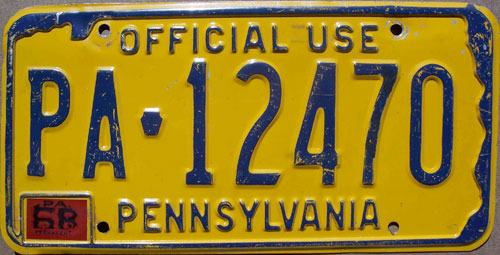 1968-1971 Official Use "Commonwealth" issue.
1968-1971 Official Use "Commonwealth" issue.
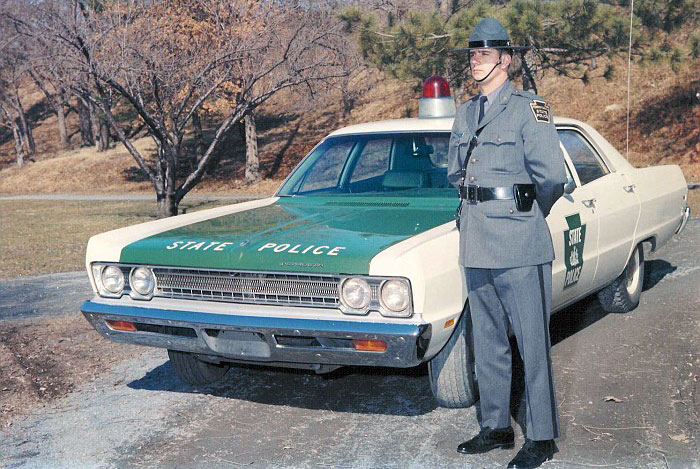
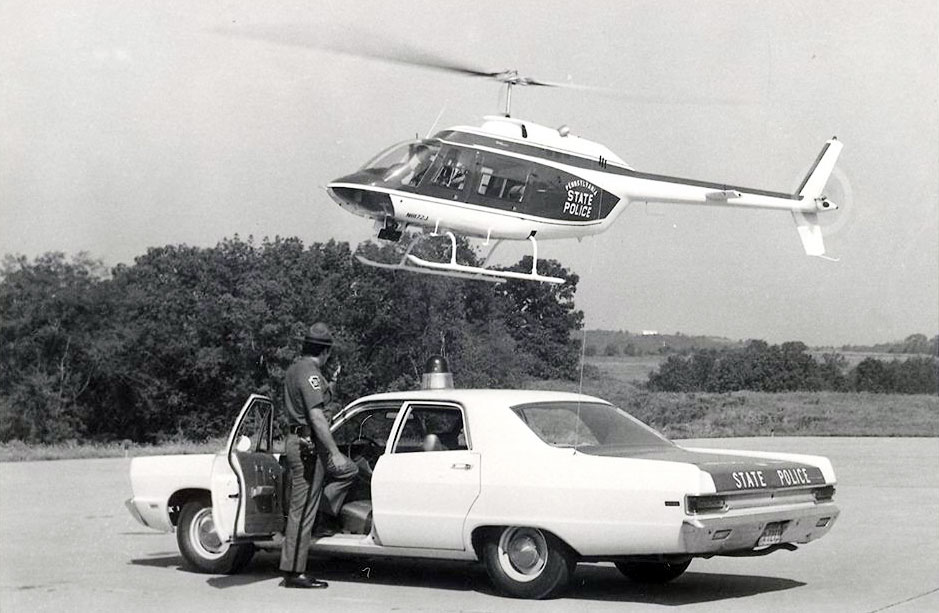
In 1971, a new OFFICIAL USE Commonwealth license plate was issued to replace both the 1965 and the 1968 issue. The plate design did-away with the state outline in favor of a plain embossed perimeter border. The embossed aluminum plates were colored yellow over dark blue. OFFICIAL USE was still embossed between he upper mounting holes and PENNSYLVANIA was embossed between the lower mounting holes. The PA prefix continued with the keystone-shaped dash followed by five numbers. These plates were issued until 1977.
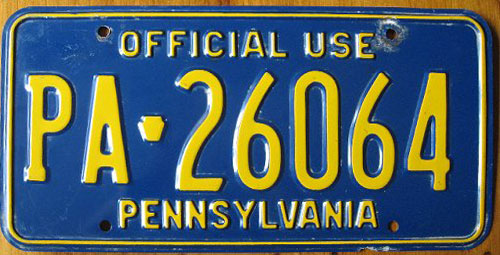 1971-1977 Official Use "Commonwealth" issue.
1971-1977 Official Use "Commonwealth" issue.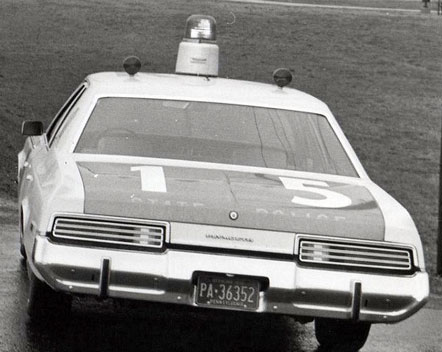
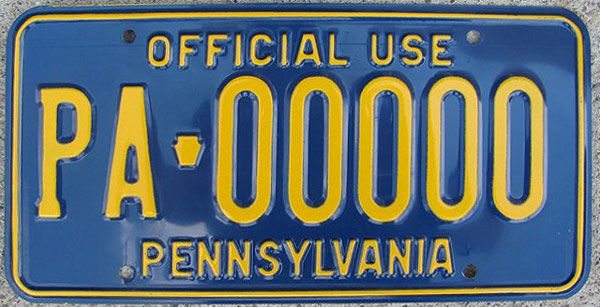 1971-1977 Official Use "Commonwealth" SAMPLE issue.
1971-1977 Official Use "Commonwealth" SAMPLE issue.
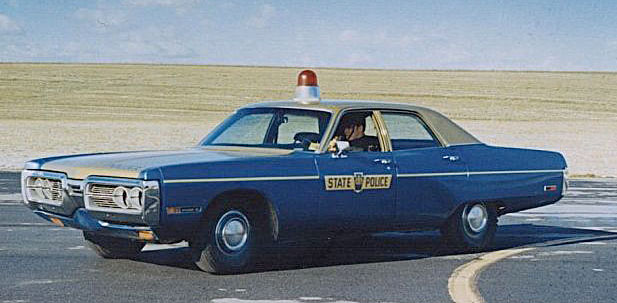
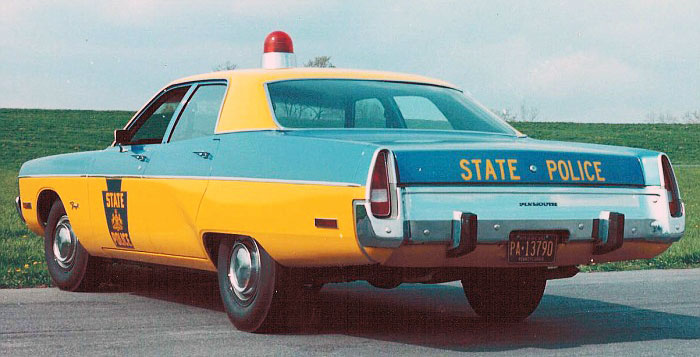
From 1953 until 1972, Pennsylvania State Police cars did not run any front license plates. Yet it was in April of 1972, that the PSP decided to adorn the front of their fleet of brand new blue and yellow Plymouth Furys with titled state police license plates. The plates were in the same yellow/gold over dark blue (officially known as Golden Yellow and Ultramarine Blue) color scheme as the Commonwealth plate run on the rear of the car. STATE over POLICE was inscribed in reflective yellow/gold as was the outter perimeter of the plate.
A version with thinner and more spaced-apart letters came out in the early years of the launch followed by a version with a larger, wider font.
These STATE POLICE front plates were no longer issued after 1974 when the PSP fleet went to a blue and white color scheme. These plates were seen used as late as 1975 before the last of them were removed.
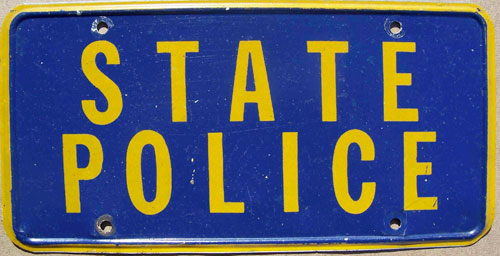 1972-1975 PSP front plate.
1972-1975 PSP front plate. 
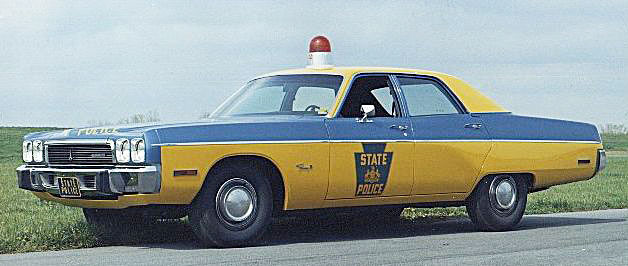
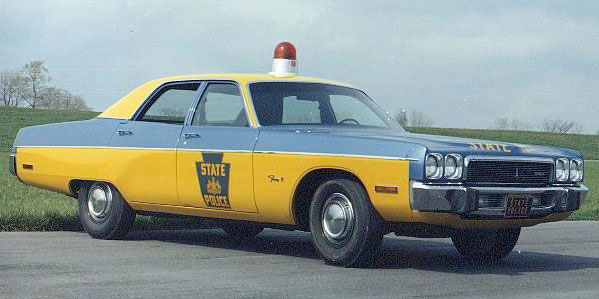
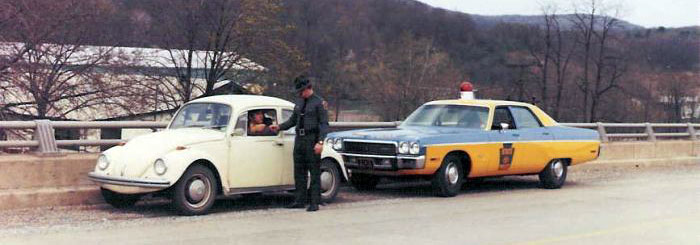
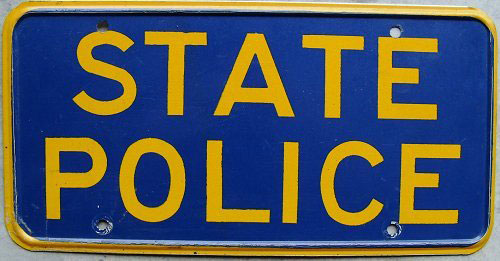 1972-1975 PSP front plate.
1972-1975 PSP front plate. 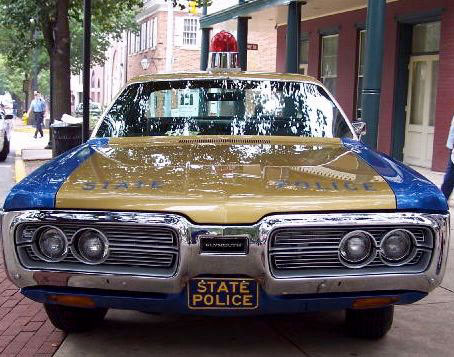
1977 saw the introduction of an entirely different Commonwealth license plate, at least as far as a color scheme was concerned. A blue over reflective white plate was chosen. This time, the state name was embossed between the upper mounting holes and OFFICIAL USE was embossed between the lower mounting holes. The PA prefix was still used, however the keystone dash was dropped in favor of a plain hyphen ahead of the 5 digit number.
These plates were issued until 1984 but still used into the early 1990's.
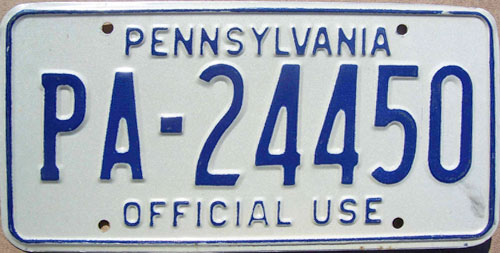 1977-1984 Official Use "Commonwealth" issue.
1977-1984 Official Use "Commonwealth" issue.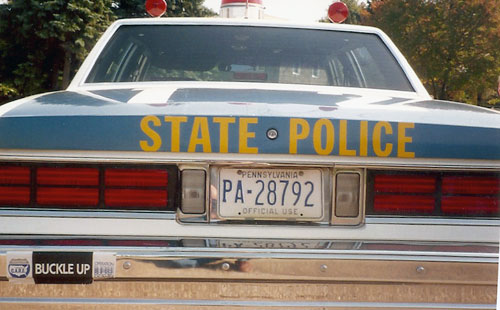
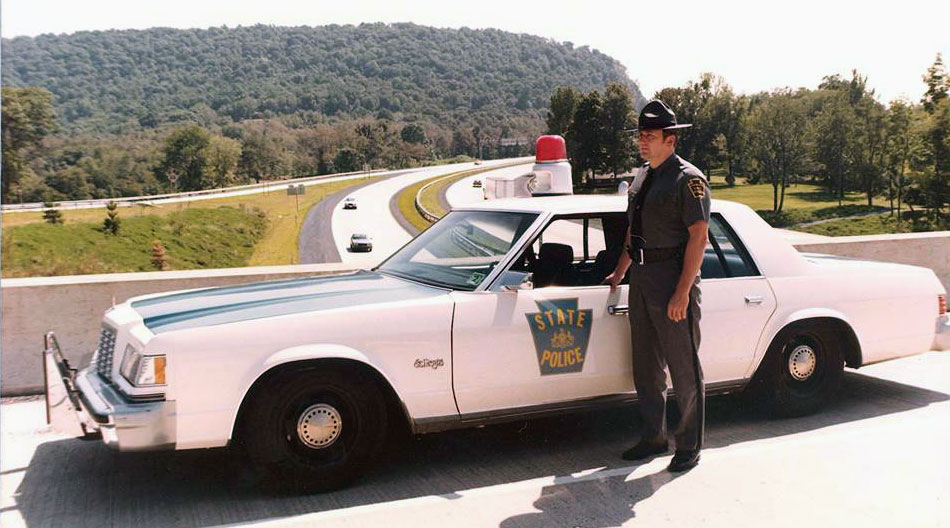
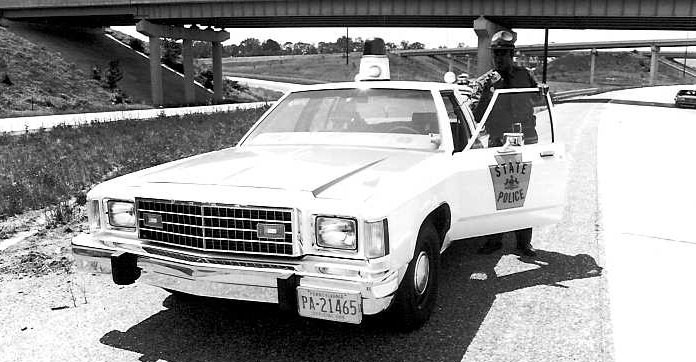
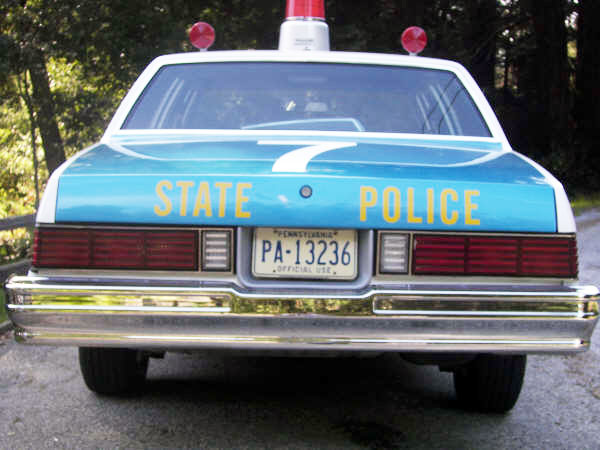
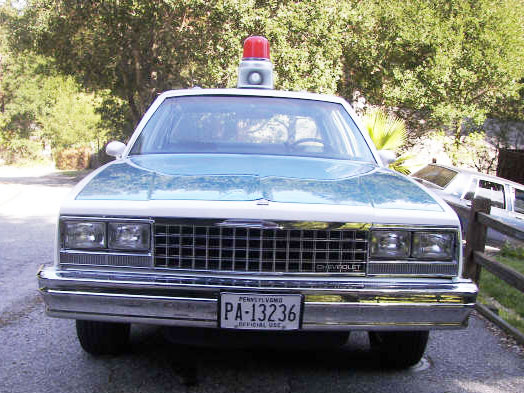
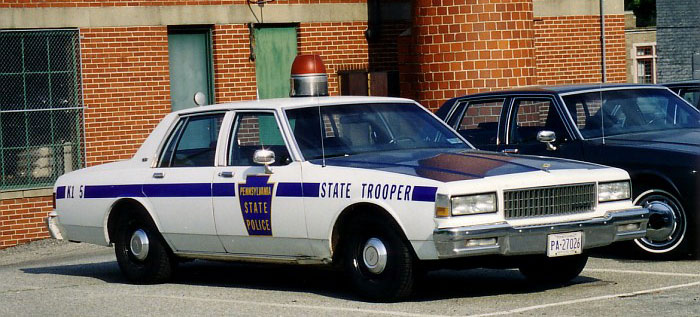
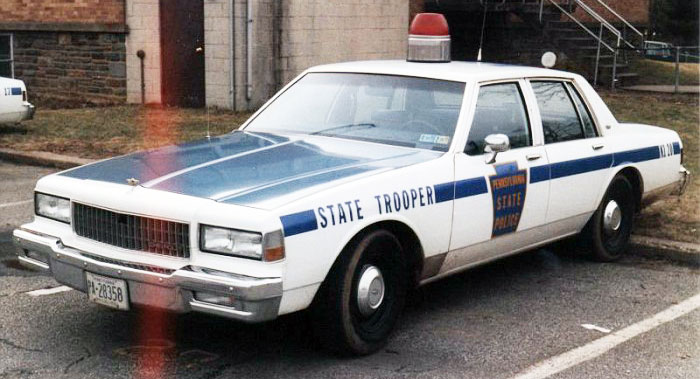
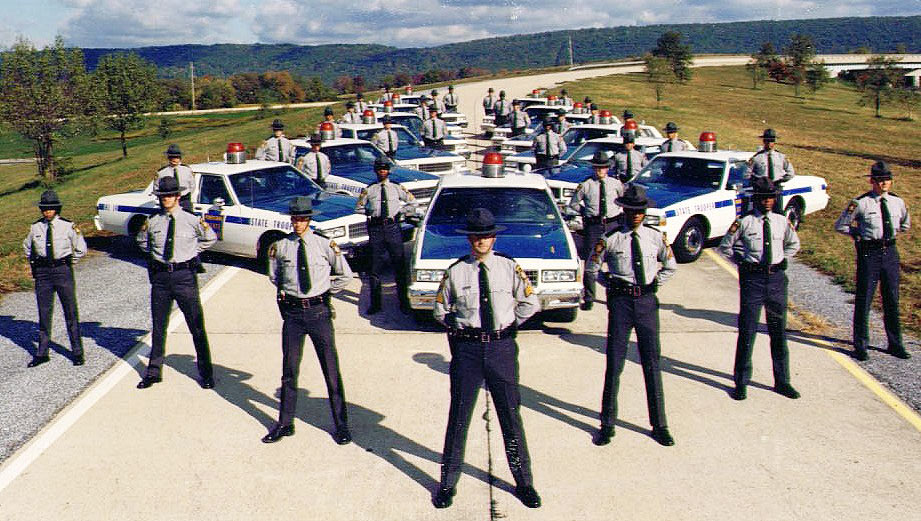
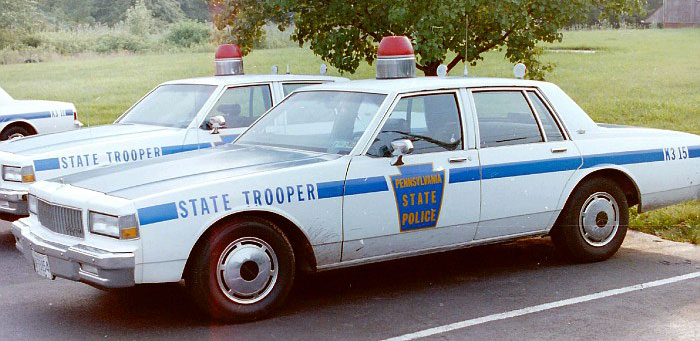
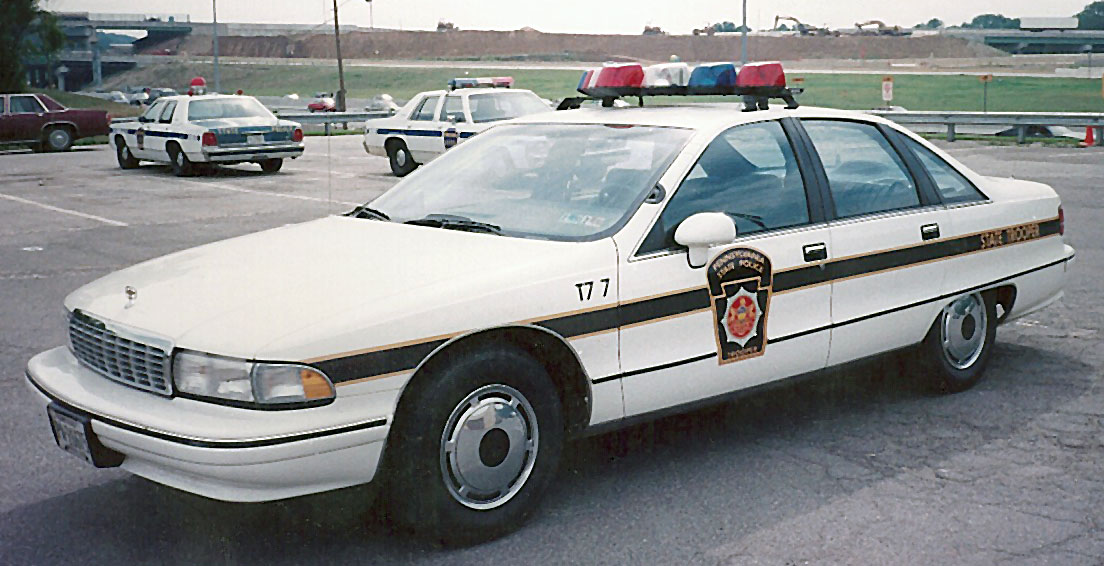
In 1984 a new Commonwealth license plate used by the Pennsylvania State Police was launched. The plate utilized reflective white embossed characters over a dark blue background. OFFICIAL USE was embossed between the upper mounting holes and PENNSYLVANIA was embossed between the lower mounting holes.
PA was still used in the prefix position until about 1994 when it switched to the suffix position.
These plates were used well-into the 2000's and the version with the PA in the suffix position continues to this day.
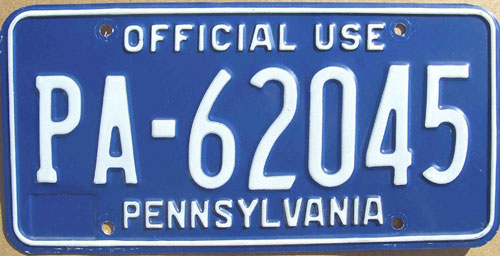 1984-current Official Use "Commonwealth" issue.
1984-current Official Use "Commonwealth" issue.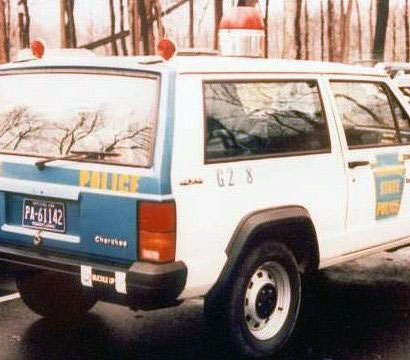
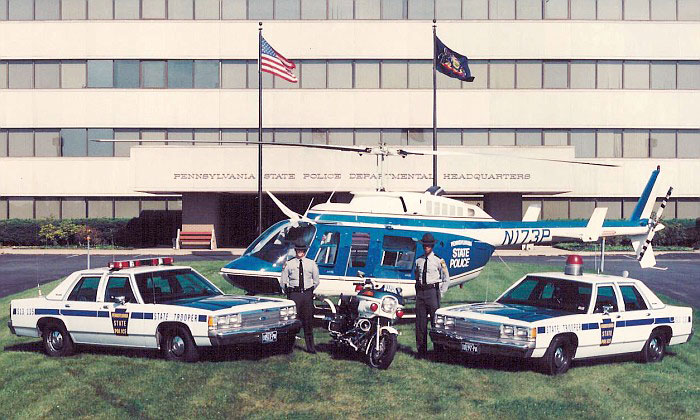
The current issue Commonwealth license plate used by Pennsylvania State Police had the PA in the suffix position since at least 1994.
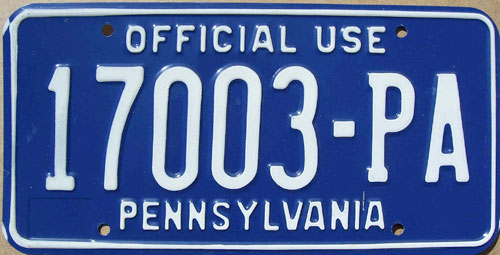 Circa 1994-Current Official Use "Commonwealth" issue.
Circa 1994-Current Official Use "Commonwealth" issue.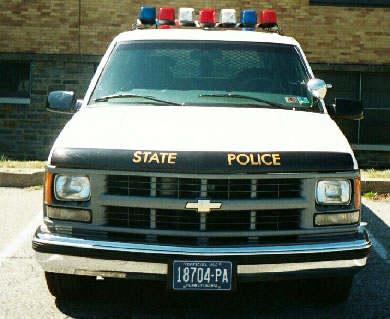
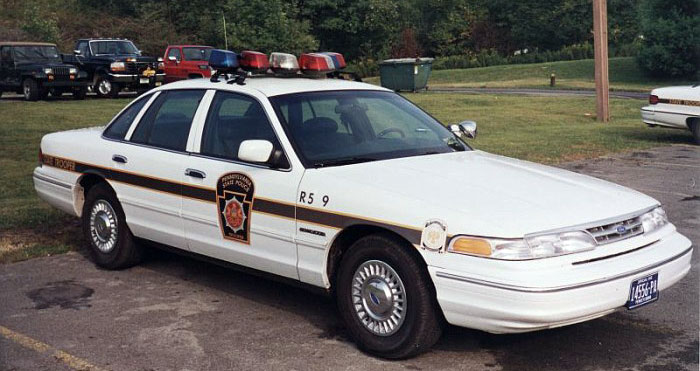
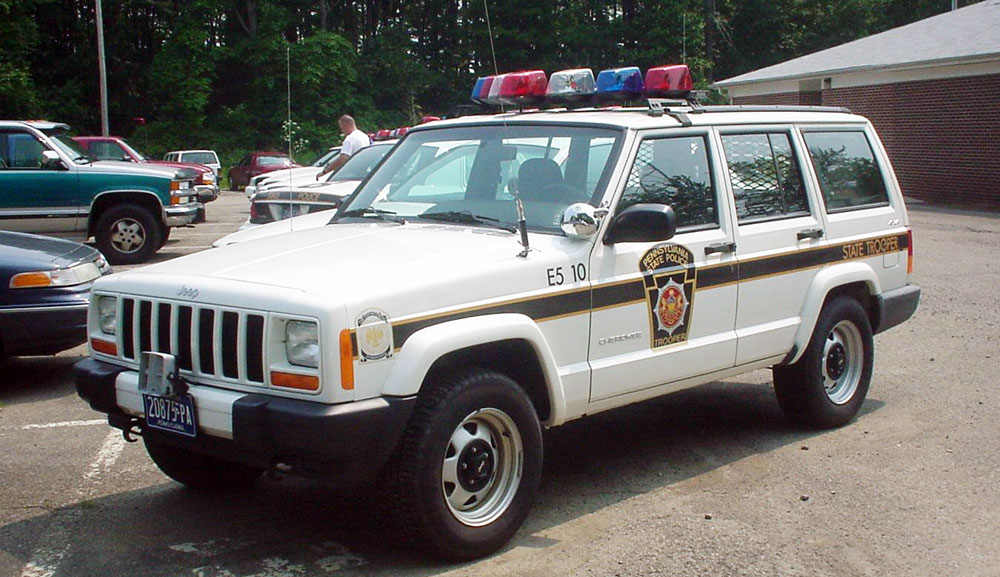
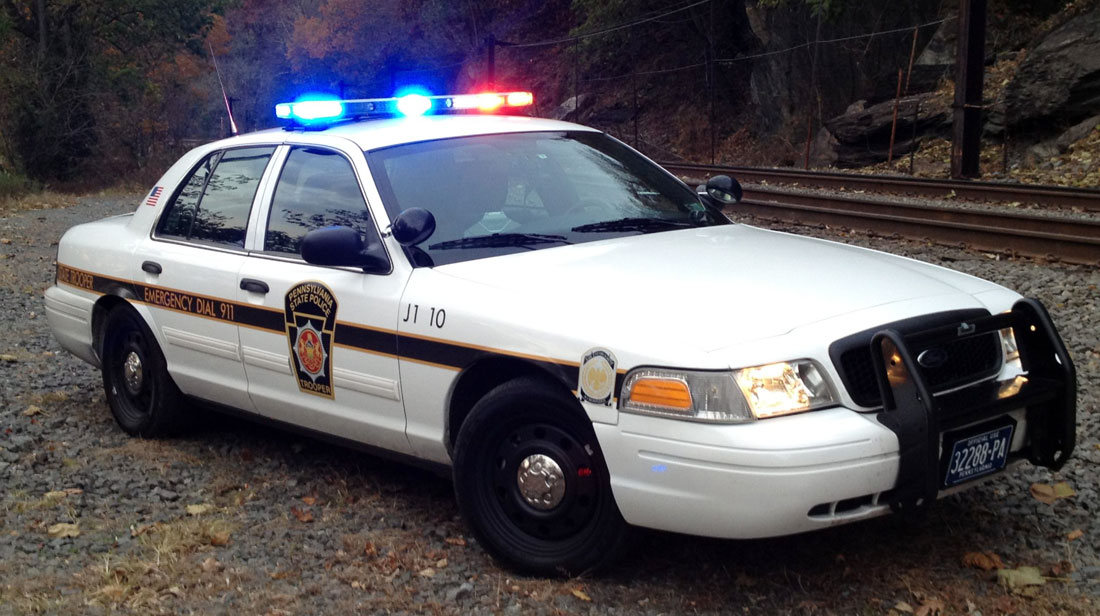
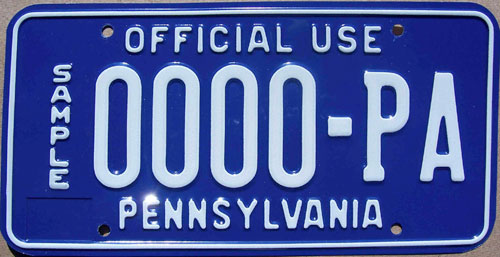 Circa 1994-Current Official Use "Commonwealth"
Circa 1994-Current Official Use "Commonwealth" 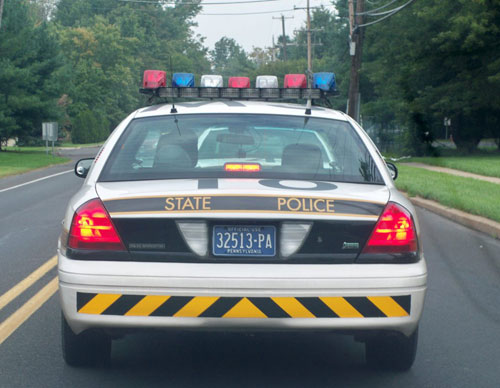
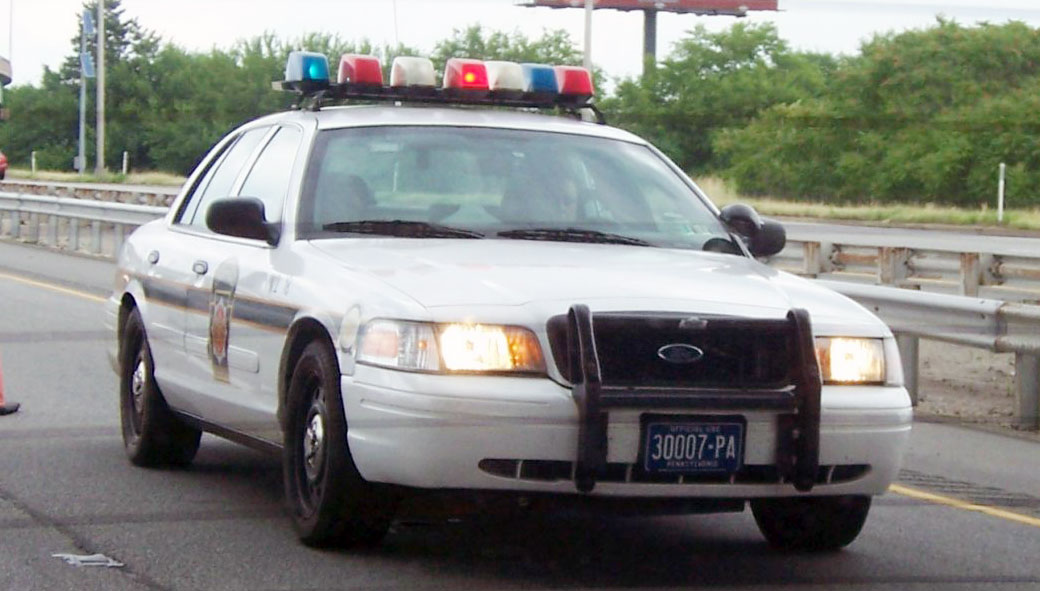
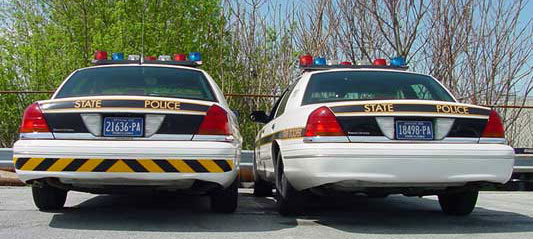
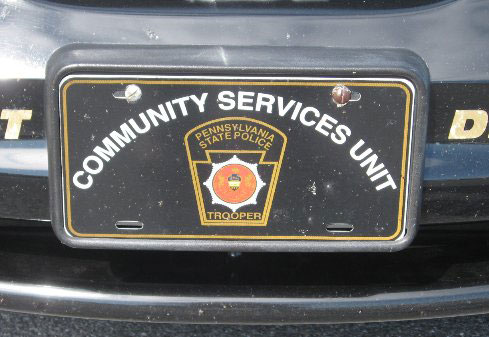 Special issue- Community Services Unit.
Special issue- Community Services Unit.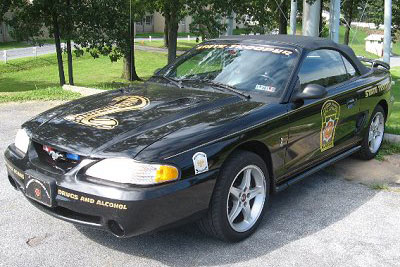 Community Services Unit
Community Services Unit 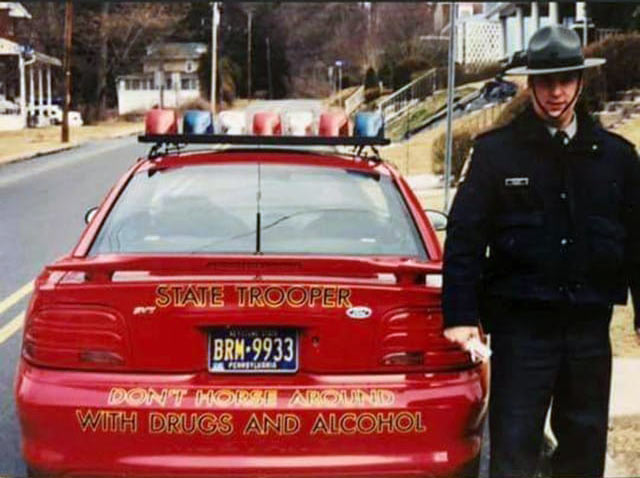 (Courtesy Royce Capehart)
(Courtesy Royce Capehart) 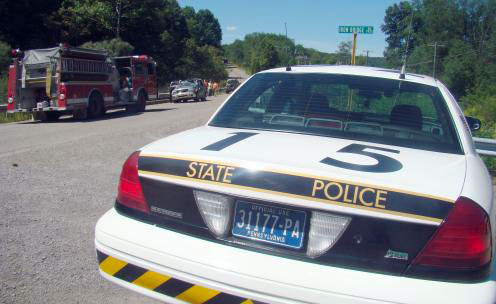
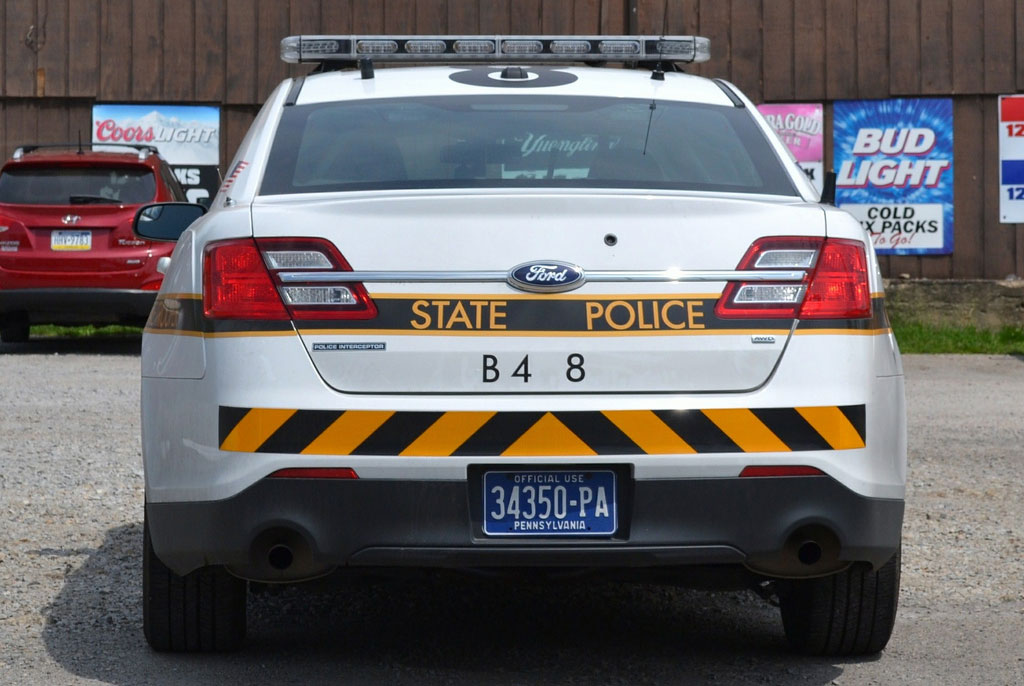
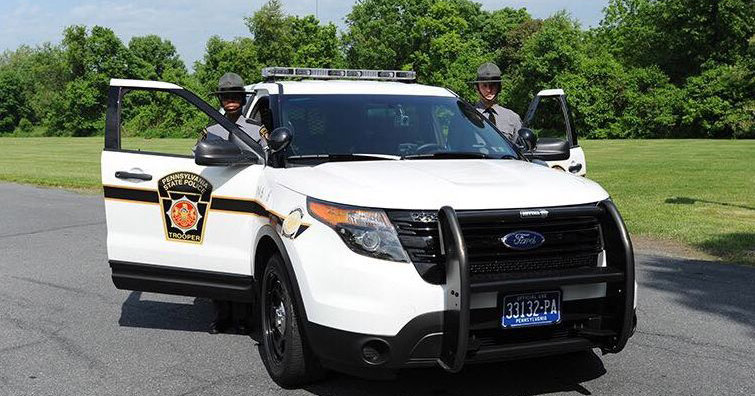
Somewhere in early 2022, the Pennsylvania State Police broke a century of tradition by introducing an agency-specific license plate featuring the PSP emblem. The embossed aluminum plate has a reflective white background and medium blue characters. A blue band spans the upper tier of the plate and then forms a blue border for the rest of the plate. Inside that blue band is the state name in white along with a state outline in white in the top left corner.
The bottom tier of the plate features a yellow span with OFFICIAL USE silkscreened in dark blue.
A full-color rendition of the PSP emblem is silkscreened at the far left center field of the plate followed by a silkscreened P over A in dark blue as a stacked prefix. The registration number consists of 4 digits follwed by a V suffix.
In July of 2022, these plates were observed to be on new PSP vehilces only as older PSP vehicles were observed to still be sporting the older white over blue plain Commonwealth plates.
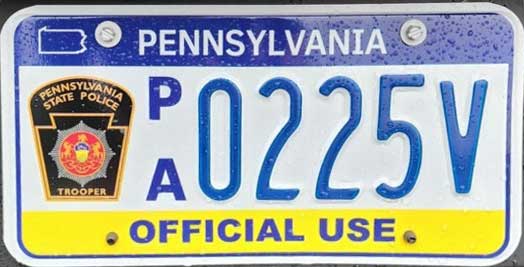 2022-Current issue.
2022-Current issue. 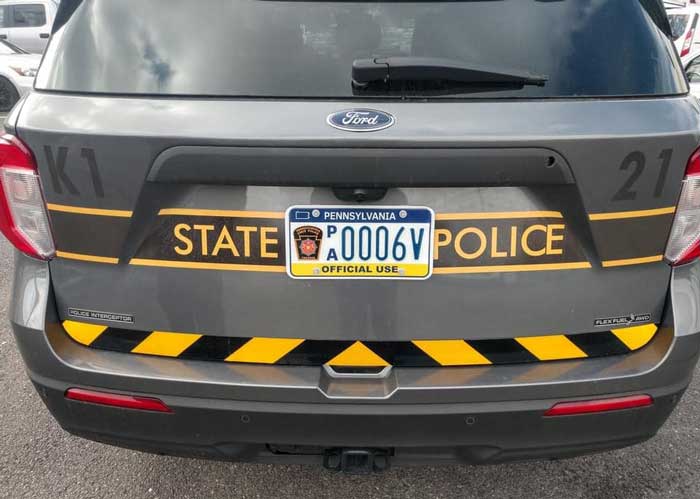 (Courtesy Dan Wetzel)
(Courtesy Dan Wetzel)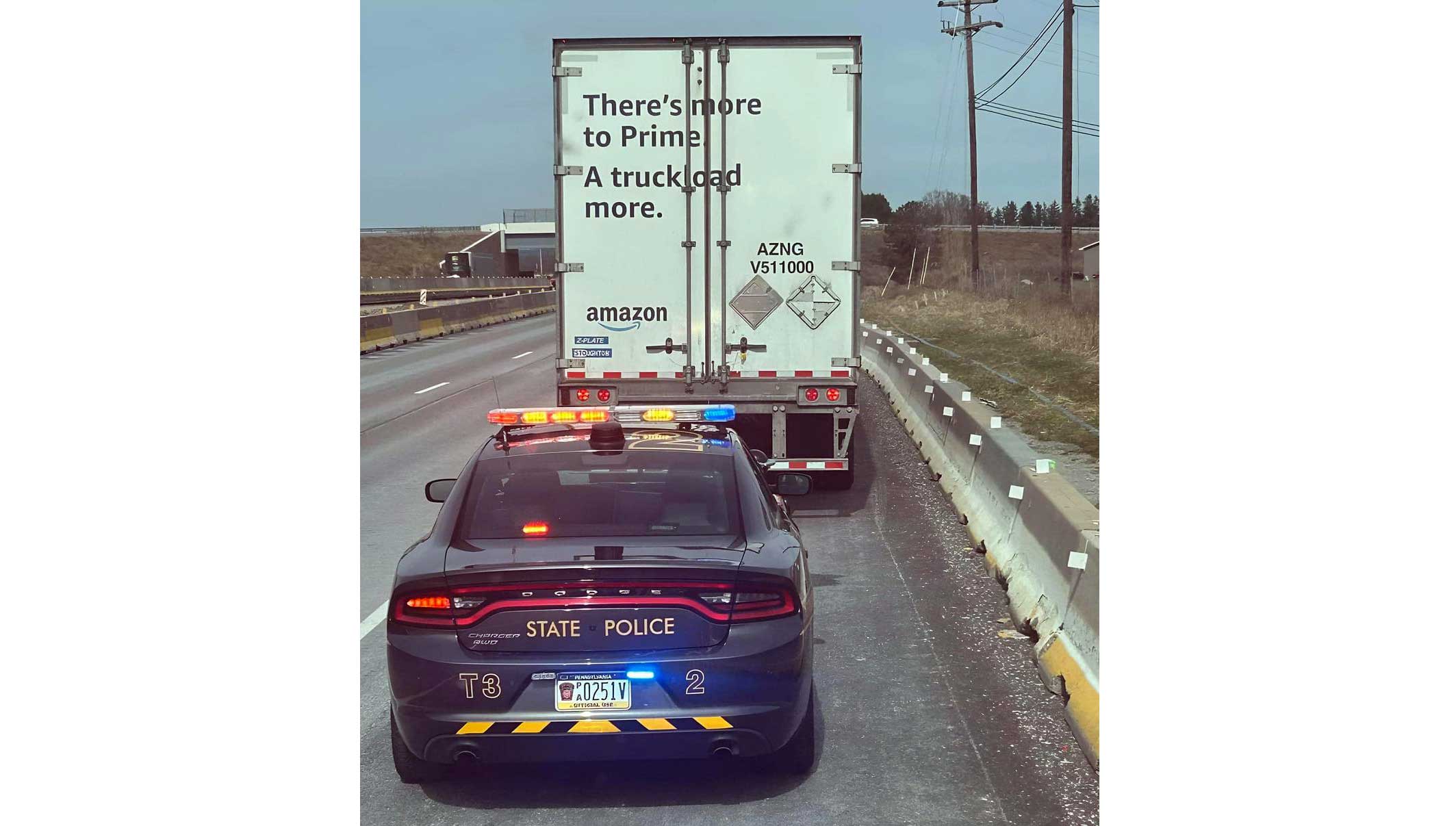 (Courtesy Jack Murphy)
(Courtesy Jack Murphy)It has been stated that the PSP obtained their first patrol motorcycles in 1919. From this time well-into the 1930's, low-numbered regular Pennsylvania motorcycle license plates were issued to the state's patrol bikes.
As with most state police agencies during the 1940's and into the 1960's, the motorcycle for patrol was gradually phased-out and by 1973, none remained in the PSP fleet.
All of this changed on Friday August 18, 1989 when fourteen newly-trained PSP troopers took hold of their twelve new Harley Davidson FXRP motorcycles to resume motor patrol in the Keystone State. Only eight of the twelve patrol cycles were immediately assigned- five to Findlay, two to Harrisburg and one to Philadelphia. The other four bikes were assigned later.
These PSP motorcycles all ran regular motorcycle license plates one being number 3FL2C. Motorcycles of the PSP continue to run basic motorcycle license plates.
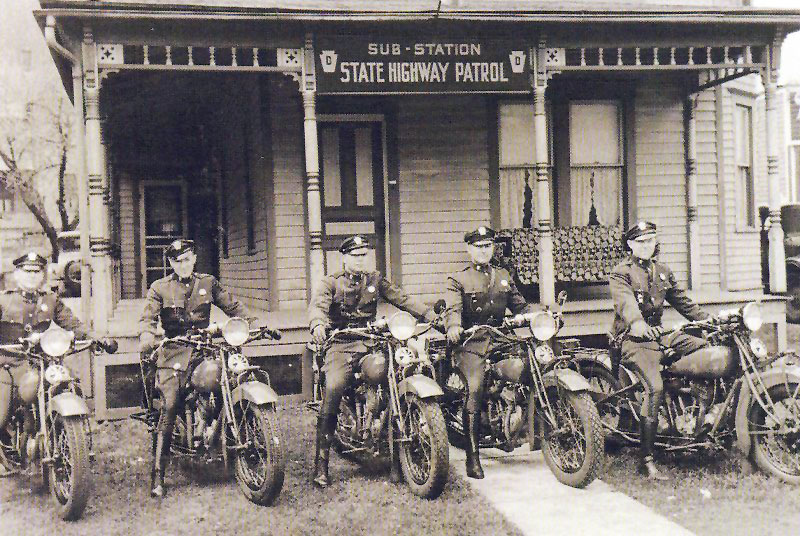
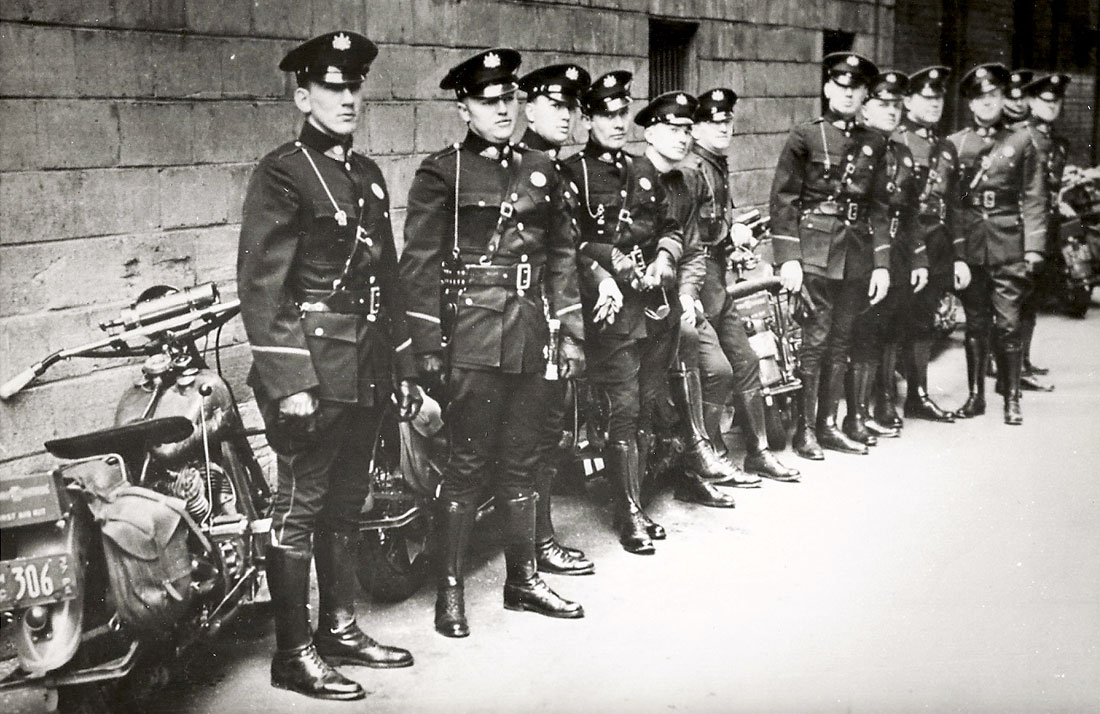
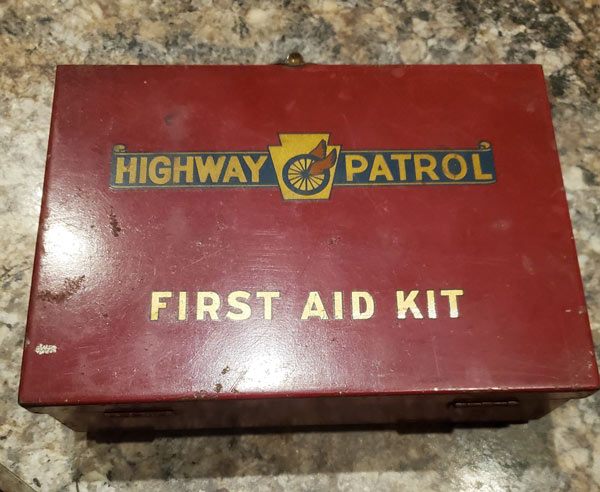 Circa 1930's PHP First Aid Kit as seen mounted on the rear of the patrol motorcycle seen at right. As the PHP only ran standard Pennsylvania motorcycle plates, the First Aid Kit provided the identifier on the rear of the cycle.
Circa 1930's PHP First Aid Kit as seen mounted on the rear of the patrol motorcycle seen at right. As the PHP only ran standard Pennsylvania motorcycle plates, the First Aid Kit provided the identifier on the rear of the cycle.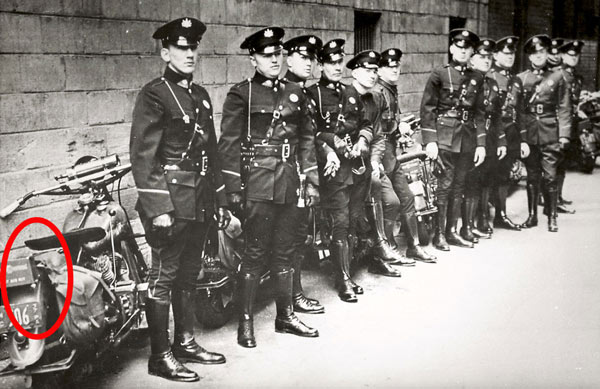 1937
1937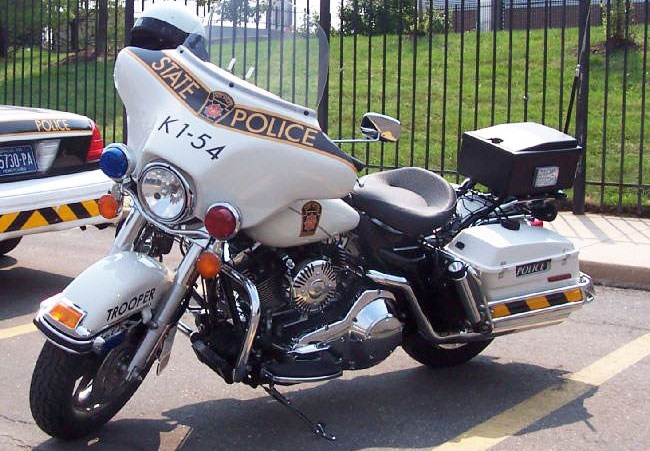
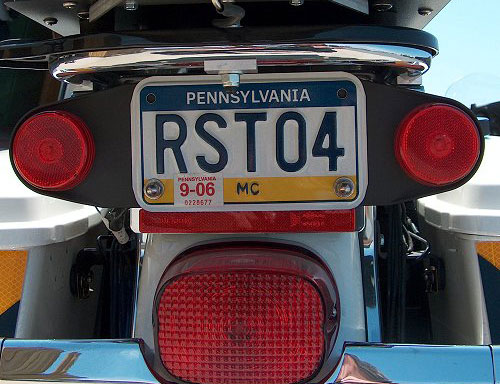
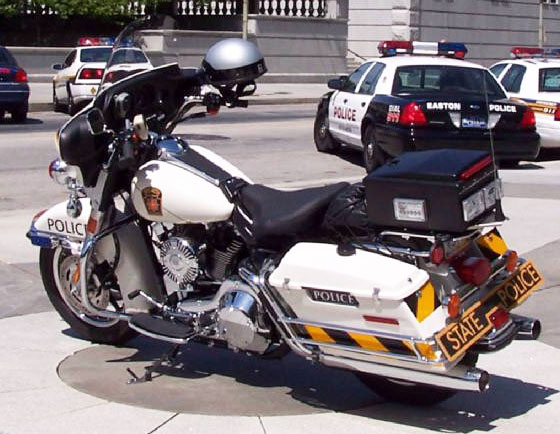
The following are specialty issues mostly for non-duty use.
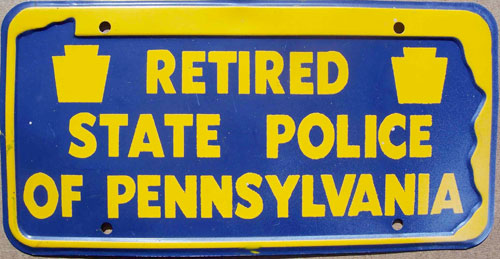 Circa 1960's issue for PSP retiree for use on personal vehicle.
Circa 1960's issue for PSP retiree for use on personal vehicle.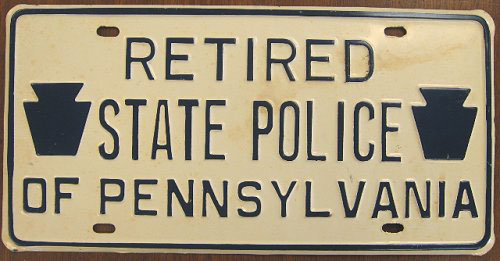 Circa 1960's issue for PSP retiree for use on personal vehicle.
Circa 1960's issue for PSP retiree for use on personal vehicle.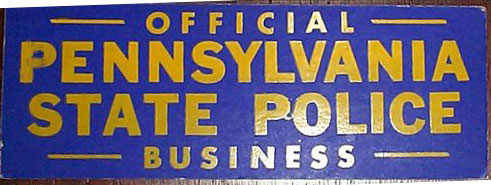 1950's-60's dashboard sign
1950's-60's dashboard sign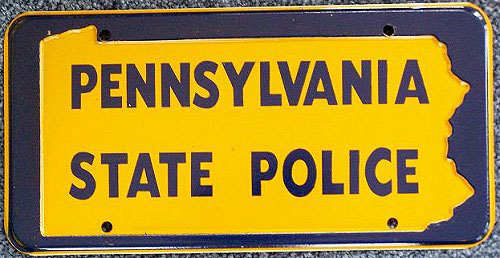 Circa 1960's "booster" issue for use on personal vehicle.
Circa 1960's "booster" issue for use on personal vehicle.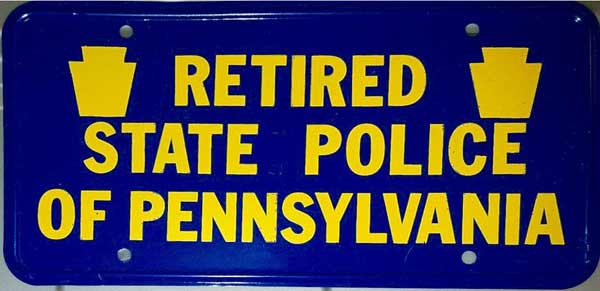 Circa 1974 issue for PSP retiree for use on personal vehicle.
Circa 1974 issue for PSP retiree for use on personal vehicle.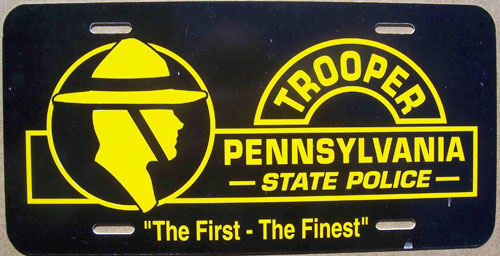 Flat-screened booster souvenir plate.
Flat-screened booster souvenir plate.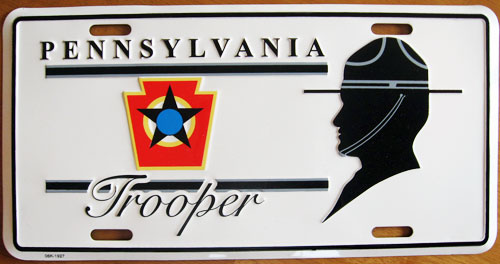 Embossed tin booster souvenir plate.
Embossed tin booster souvenir plate.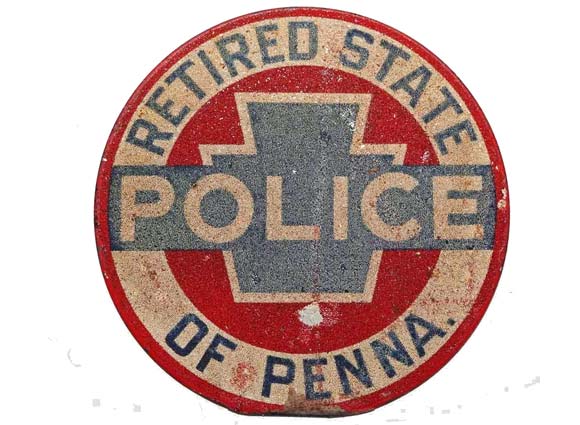 Retired PSP car emblem.
Retired PSP car emblem. 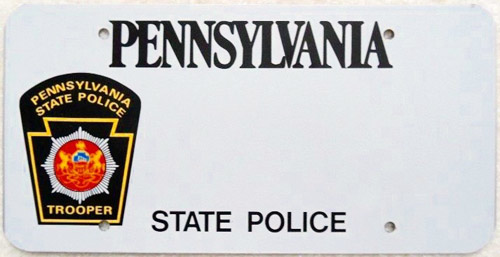 Proposed PSP graphic license plate blank.
Proposed PSP graphic license plate blank.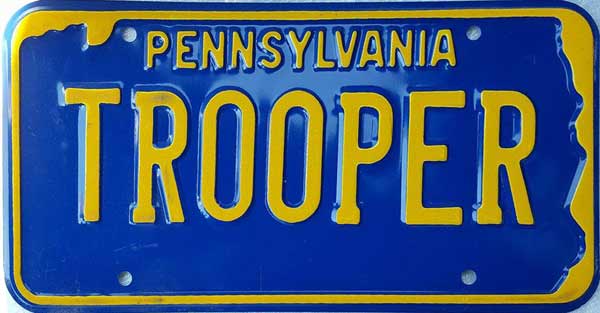 State-made special order issue for members of a particular Troop.
State-made special order issue for members of a particular Troop.